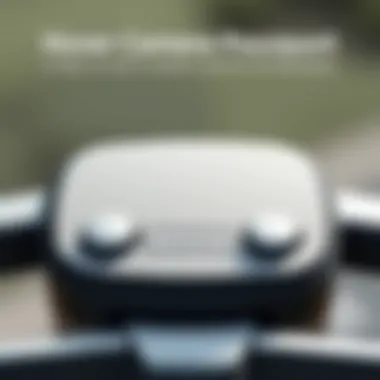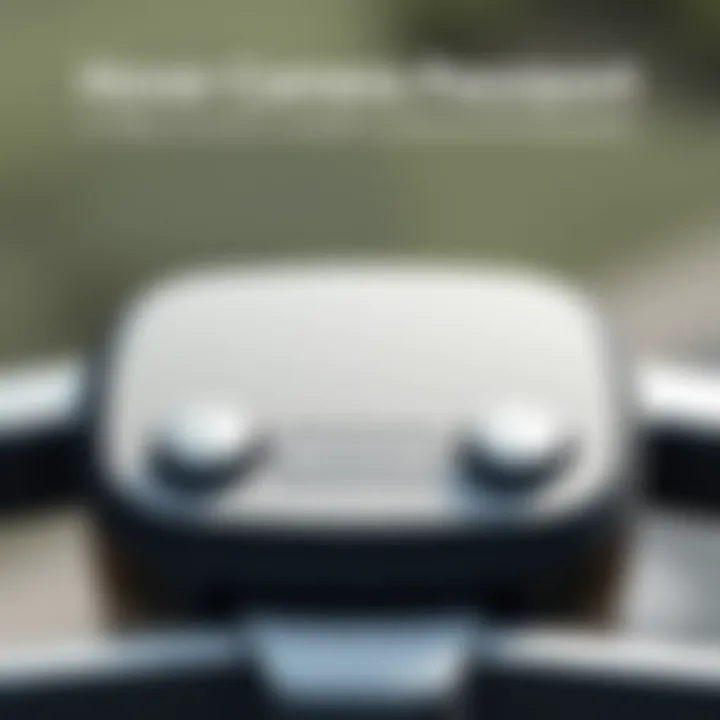Hover Camera Passport: A New Era in Aerial Photography


Intro
The world of photography has taken a dramatic leap forward, influenced heavily by technological advancements. Among these innovations, the Hover Camera Passport emerges as a notable contender, making waves in the realm of aerial imaging. Its design emphasizes user-friendliness while not skimping on the advanced features necessary for both casual snapshots and professional-grade captures. But is it all it’s cracked up to be? This article endeavors to dissect the device, unearthing its core facets, uses, and how it compares with similar gear.
As we venture into this exploration, we will highlight its key features, technical specifications, and performance metrics that could sway potential buyers. A myriad of concepts will be discussed - from mounting it effectively to various insights gathered through real-world applications, and we’ll touch on where this device fits into the digital snapshot tapestry.
So what sets this camera apart? How does it shape the user experience for photography enthusiasts and casual users alike? Let’s dive in.
Prelude to Hover Camera Passport
The Hover Camera Passport is at the forefront of a new wave in personal aerial photography, drawing both hobbyists and serious photographers into its orbit. As technology continues to evolve, it’s essential to keep tabs on how compact devices like the Passport are reshaping the landscape. The significance of this discussion lies in recognizing the unique advantages that such a device can provide, especially in an era when the demand for mobility and usability is skyrocketing.
Overview of Drone Technology
Drone technology has burgeoned in the last decade, finding usefulness across various sectors, from agriculture to entertainment. These machines are equipped with various sensors and cameras, allowing for stunning imagery and data collection from unique viewpoints. In essence, drones have provided a new lens through which we encounter the world.
Compact drones, such as the Hover Camera Passport, offer distinct benefits—portability and user-friendliness. No longer do enthusiasts need to navigate cumbersome setups; the Pulse of the aerial photography community lies in making these devices accessible for casual users, as well as professionals.
History of Personal Drones
Personal drones have come a long way since their inception in military applications. They landed in civilian hands in the late 1990s, primarily for fun and photography, but the real breakthrough came when advancements in technology made drones smaller, cheaper, and easier to operate. Slowly, these flying robots transitioned from being mere toys to essential tools for varying fields. As individuals saw their potential, the popularity surged, spawning a market filled with options for every budget and need.
The Hover Camera Passport symbolizes this journey, representing a fusion of innovation and practical use. It stands as a testament to the strides made in terms of user-driven design, focusing on features that matter most to the everyday user.
The Rise of Compact Drones
In a world that increasingly prizes convenience and adaptability, compact drones have found their niche. The appeal lies in their size but also in their performance capabilities. Compact models can easily fit into a backpack, making it simple for users to carry them anywhere they go.
- Portability: Compact drones are lightweight, allowing users to fly them in various settings without much hassle.
- Ease of Use: The technology has grown progressively intuitive, empowering people with little to no experience to operate them with ease.
- Versatility: From capturing breathtaking landscapes to documenting family gatherings, the productivity of compact drones translates directly into versatile utility.
In summary, the Hover Camera Passport exemplifies the union of cutting-edge technology with user-friendly functions. As we delve deeper into the subsequent sections, it becomes vital to understand its design, technical attributes, and how it enhances the user experience in the realm of aerial photography.
Design and Build of Hover Camera Passport
The design and build quality of the Hover Camera Passport fundamentally influence its usability and appeal to a diverse audience. With the increasing competition in the drone market, a well-thought-out design can be the deciding factor for tech enthusiasts and casual consumers alike. It's not just about looks; it's about functionality, durability, and user experience. Companies can often miss the mark when it comes to creating a product that performs as well as it looks, but the Hover Camera Passport attempts to strike that balance effectively.
Physical Dimensions and Weight
The physical dimensions and weight of the Hover Camera Passport play a crucial role in its portability. Constructed with a compact form, the Passport fits snugly into a backpack or even a sturdy purse, measuring just around 7.5 x 7.5 x 2 inches and weighing approximately 1.5 pounds. This lightweight design facilitates easy maneuverability, allowing users to take it to various locations without a hitch.
Being on the lighter side is an advantage, especially for photographers who enjoy outdoor adventures or casual travelers unwilling to haul around a cumbersome device. Notably, the compact size does not compromise its features, as the Passport still boasts impressive aerial capabilities.
Material Used in Construction
Construction material often dictates both the performance and longevity of tech gadgets like drones. The Hover Camera Passport makes use of high-grade materials that serve dual purposes: providing stability and reducing weight. The main body is crafted from a lightweight composite material, which gives it resilience against everyday bumps and scrapes.
Additionally, it has a protective shell that not only enhances durability but adds an aesthetic charm. However, this focus on lightweight materials means users must take extra care when handling it, as it may not withstand extreme conditions or heavy impacts as well as bulkier counterparts.
Color and Finish Options
With the growing emphasis on personal expression, color and finish options are noteworthy aspects of the Hover Camera Passport. Available in sleek monochrome shades and a striking metallic finish, the Passport doesn’t just cater to functionality but adds a touch of style.
For those who take pride in their gear, having a visually appealing drone can make a difference. The colors available resonate well with modern design trends while ensuring that the device catches the eye both in the sky and on the ground. Whether you prefer a classic black or a more contemporary silver, the options offered suit a variety of preferences, making the Hover Camera Passport a visually engaging component of any photographer's toolkit.
"A well-designed camera drone is not just a gadget, it's an essential part of capturing moments with flair and finesse."
By understanding the design and build quality of the Hover Camera Passport, potential buyers can make informed decisions. These elements collectively contribute to the overall user experience and satisfaction, making the Hover Camera Passport a genuinely compelling choice in the realm of personal aerial photography.
Technical Specifications
The realm of aerial photography hinges heavily on the technical specifications of the devices employed, and the Hover Camera Passport is no exception. Understanding its specs can greatly influence a user’s experience, from capturing breathtaking images to navigating its functionalities with ease. Each facet, including camera capabilities, flight features, and battery mechanics, play a pivotal role in how effectively and efficiently one can utilize this compact drone. Whether you’re a seasoned photographer or just dipping your toes into the world of drones, recognizing these details can ensure you’re making a well-informed choice.
Camera Capabilities
Resolution and Image Quality
Resolution and image quality are two sides of the same coin when it comes to photography. The Hover Camera Passport boasts a camera capable of delivering stunning 12MP still images. This specification contributes significantly to an enhanced overall experience by allowing users to capture intricate details in their photos, making them suitable for both casual sharing and professional portfolios. The quality of an image is often judged by its sharpness and clarity, and the camera on this drone does not disappoint. The crispness provided caters well to those who value high fidelity in their images.
One noteworthy feature is the ability to shoot in HDR mode, which optimally balances the light and shadows in your images, especially in challenging lighting conditions. However, it’s worth mentioning that some users may find that in very low light situations, the image quality can drop, introducing some graininess that might affect the results.


Video Recording Features
In today’s visual world, capturing high-quality video is just as critical as photography. The Hover Camera Passport allows for 4K video recording at 30 frames per second, which is a solid choice for both personal use and content creation. This feature not only enhances the video’s clarity but also makes it appealing for social media influencers and casual creators alike, looking to bring their audience immersive content.
Moreover, the option for 1080p at 60 frames per second gives the user versatility, catering to various preferences and project needs. However, while the ample resolution enhances replayability, it should be noted that the file sizes can be quite large, which may pose storage concerns after prolonged use.
Stabilization Technology
Stabilization technology is a critical component in drone cinematography, and the Hover Camera Passport employs advanced electronic image stabilization (EIS). This technology plays a vital role in minimizing the shakiness that often occurs during flight. Thanks to this system, videos appear smooth and polished, which is instrumental for capturing exciting footage without the distraction of jittery movements.
A significant advantage of this feature is that it allows even novice users to create professional-looking videos without requiring extensive editing skills. However, one limitation might be that extreme movements or rapid turns could still lead to slight instability in footage, potentially disappointing those demanding perfection.
Flight Features
Flight Time and Range
One of the most critical aspects of any drone is how long it can stay airborne, and the Hover Camera Passport shines with a flight time of around 10 to 12 minutes. While this may seem modest, it’s relatively typical for drones in its compact class. The range of around 20 to 30 meters is ideal for personal use, allowing users to get a good distance while keeping the drone well within sight.
This flight time lends itself to efficient shooting sessions without the fear of abruptly landing due to low battery. Nevertheless, potential users should consider that prolonged video recording might lead to more rapid battery drainage compared to still photography.
Navigation Systems
Navigating with precision is crucial in flying drones. The Hover Camera Passport comes equipped with intuitive navigation systems which include GPS and 2.4GHz Wi-Fi connectivity. These technologies facilitate seamless flying experiences, offering path tracking and smart return-to-home features, which are vital for beginners who might have trouble returning the drone manually.
However, some users might experience connectivity issues, particularly in areas with a significant amount of interference, which could hinder its navigation capabilities. Still, it’s a strong feature that enhances user confidence when flying this drone, particularly for less experienced individuals.
Obstacle Avoidance
The Hover Camera Passport’s obstacle avoidance system is a notable feature that enhances safety and usability. By utilizing sensors, it helps to detect and avoid obstacles during flight, which is particularly beneficial for novice users who might not be accustomed to potential hazards around them.
Nevertheless, this technology does have its limitations. While it performs reliably in many situations, sudden movements or unforeseen obstacles might catch the drone off guard. This fact emphasizes the need for pilots to remain aware of their surroundings even when automated systems are at play.
Battery and Charging Mechanics
Battery Life
Battery life is often a dealbreaker for many drone users. The Hover Camera Passport’s battery has a capacity that supports its roughly 10 to 12 minutes of flight time. Many enthusiasts will see this as acceptable, though frequent flyers may find themselves more inclined to invest in additional batteries to maximize their time aloft.
A unique advantage is that its modular design enables effortless swapping of batteries mid-flight, thus minimizing downtime if you have spares handy. However, knowing when to recharge can be somewhat tricky, as the battery level indicators may not always provide precise information.
Charging Options
When it comes to recharging, the Hover Camera Passport offers versatile charging options, including USB-C compatibility, which aligns perfectly with modern tech trends. This means recharges can be accomplished using phone chargers or power banks, enhancing convenience for travel or outdoor use.
However, the downside of this feature is that charging can take a bit longer when compared to dedicated fast chargers, which might frustrate users keen on jumping back into the action ASAP.
Replacement and Upgrades
The drone market is ever-evolving, and the Hover Camera Passport does provide options for replacements and upgrades, which reflects a forward-thinking approach to design. Parts like batteries and propellers can be easily sourced and replaced, ensuring ongoing functionality even after prolonged use.
On the other hand, while the option for upgrades exists, the proprietary nature of some components can limit compatibility with third-party products, potentially putting a damper on user customization desires. Nevertheless, the ability to maintain and enhance the drone is a considerable advantage in the long run.
Usability and User Experience
In the world of drones, usability and user experience stand tall as pivotal factors that can make or break a product, especially for something like the Hover Camera Passport. With a plethora of consumers ranging from tech enthusiasts to casual hobbyists, it’s essential that the drone not only performs well but is also intuitive to use. A positive user experience fosters repeat usage and elevates the perception of the brand in a saturated market.
Key elements include setup, application integration, and the overall interface. When users find that assembling and operating their device is a breeze, they're going to be more inclined to take it out for a spin. Moreover, in this age of technology, a seamless mobile application can be a game-changer, offering users the ability to control their drones, tweak settings, and view captured media all in one place.
Setup and Configuration Process
Setting up the Hover Camera Passport is designed to be as straightforward as possible, potentially drawing in users who might shy away from more complex systems. The initial process starts with unboxing the camera; right out of the pack, it feels lightweight yet sturdy, and the materials used speak volume about its portability.
- First, users simply have to charge the battery for a while to ensure maximum performance on their maiden flight. The battery life claims are backed by personal experiences from the community, lending credibility.
- Following that, the drone can be connected to a mobile device using Wi-Fi, bypassing the need for any cumbersome wires. This allows users to immediately dive into the app setup.
- The app itself typically offers guided steps, which make sure that users won’t find themselves stuck midway through configuration. Color coding and friendly prompts help mitigate frustration during these early stages.
Understanding the neet to cater to both newcomers and seasoned flyers, the setup reflects thoughtful design that helps even the least tech-savvy individuals feel competent.
Mobile Application Integration
A solid mobile application is akin to an ace up the sleeve for the Hover Camera Passport. The app enhances the user experience by consolidating various functionalities into a single platform. Upon installation, users are greeted with an intuitive interface that prioritizes ease of access.
- Flight Commands: Users can take off, land, or even adjust the camera angle with just a few taps. The live view feature allows for real-time feedback, which is crucial for capturing that perfect shot.
- Editing Tools: Perhaps the cherry on top is the editing suite that users can access through the app. Simple editing options allow for quick tweaks, and these can be shared directly to social media platforms like Instagram or Facebook.
- Firmware Updates: The app also keeps users informed about any software updates, ensuring they have access to the latest features and improvements.


Without a doubt, the mobile application enhances not just usability but also engagement, allowing users to interact with their device in ways that go beyond traditional controls.
User Interface and Controls
The user interface of the Hover Camera Passport strikes a fine balance between sophistication and simplicity. The controls are laid out in a manner that feels natural, which can quickly lead to muscle memory over time. This factor reduces the learning curve significantly for new users.
- Physical Controls: The drone features a few on-device buttons, which include power and takeoff. Everything else is conveniently handled within the app. This layout frees users from a clunky remote, streamlining the overall experience.
- Feedback Mechanisms: Visual indicators guide users, showing battery life and signal strength, ensuring they never lose touch with their drone.
As the tech landscape continues to evolve, the Hover Camera Passport stands out, leading to higher satisfaction among users who no longer have to endure difficult controls. The accessibility of this camera will ultimately be part of its legacy.
The Hover Camera Passport’s usability is not merely a feature; it defines the very experience of aerial photography for many.
By prioritizing user experience, the Hover Camera Passport has the potential to appeal not just to seasoned drone operators but also to budding enthusiasts looking for a user-friendly entry into aerial photography.
Comparative Analysis
A comparative analysis sheds light on the strengths and weaknesses of the Hover Camera Passport in relation to its peers. It offers potential buyers a clearer picture of how this compact drone holds up against the competition, which could be crucial for making an informed purchasing decision. With so many drones available today, it's not just about features anymore; it's about how those features measure up to customer expectations, application needs, and budget constraints. The analysis helps delineate what sets the Hover Camera apart, ultimately providing valuable insights for tech enthusiasts, casual consumers, and creatives alike.
Comparison with Other Compact Drones
When it comes to compact drones, the market is brimming with options. The Hover Camera Passport does not exist in a vacuum; instead, it competes with similar models such as the DJI Mavic Mini and the Parrot Anafi. Each model has unique characteristics that appeal to different types of users.
- DJI Mavic Mini: Known for its sturdiness, it offers exceptional battery life but sacrifices some portability for a more robust design. Conversely, the Hover Camera Passport prioritizes lightweight and travel-friendly build while still maintaining a user-friendly experience.
- Parrot Anafi: This drone impresses with its 4K camera capabilities and unique vertical tilt feature, but lacks some of the automated functionalities that make the Hover Camera Passport a hit among first-time drone users.
Comparing these models hinges on user priorities. For those who value portability and ease, the Hover Camera Passport ticks many boxes, while others may lean toward more balanced options or premium features found in competitors.
Market Positioning
The Hover Camera Passport positions itself uniquely in the ever-expanding drone landscape. It markets to a broad audience, targeting not just professional videographers but also hobbyists, travelers, and social media aficionados. Its compact design and comprehensive feature set make it an attractive option for creators looking to capture high-quality aerial shots without lugging around bulky equipment.
Moreover, the marketing strategies have largely focused on user-friendly attributes, ease of use, and capturing spontaneous moments, encouraging users to share their experiences on platforms like Instagram and TikTok. In a way, this positioning makes it appealing not only for personal use but also as a recommended tool for content creators.
Price Point and Value Proposition
Pricing is where consumers often decide which drone will ultimately find its way into their hands. The Hover Camera Passport sits in the mid-range category, presenting a value proposition that matches its capabilities. At a competitive price point, it offers many features that attract buyers, such as:
- Easy portability, allowing drone enthusiasts to take it anywhere without much hassle.
- Satisfactory camera performance, which caters to those eyeing quality photography and videography without breaking the bank.
- User-friendly interface, making it approachable for the uninitiated yet effective for seasoned users.
While the price might not position it as the cheapest option, its features provide substantial bang for the buck. As such, the Hover Camera Passport reflects a solid investment for those seeking to explore the world of aerial photography without compromising on quality or ease of use.
"When you peel back the layers, it becomes clear that the Hover Camera Passport offers not just a device, but a whole experience tailored for budding aerial photographers and seasoned travelers alike."
Ultimately, the comparative analysis reinforces the notion that buying a drone isn't just a transaction; it's about understanding what fits your needs best and how various options can complement your aerial adventures.
Practical Applications
Understanding the practical applications of the Hover Camera Passport provides insight into how this technology can be utilized effectively. Unlike traditional photography methods, where bulky equipment is a norm, the Hover Camera Passport extends a new realm of possibilities for both amateur and professional photographers. It’s not just about capturing moments; it’s about capturing them in a way that’s innovative and effortless. Below, we delve into specific applications that highlight the device's versatility and importance.
Aerial Photography and Videography
Aerial photography has come a long way, and the Hover Camera Passport significantly enhances this art. Its compact size doesn’t impede its ability to shoot 4K videos and high-resolution images. The ability to capture sweeping views from above not only adds an appealing perspective to any shoot but also enables users to document landscapes with a unique touch.
With its user-friendly interface, even those new to aerial photography can master it quickly. The automatic tracking feature allows the drone to follow moving subjects seamlessly, making it great for capturing action shots without the complexity of remote controls. Moreover, the stabilization technology built into the Passport helps in delivering smooth footage regardless of wind conditions. This aspect makes it particularly valuable for content creators who focus on dynamic environments, such as sports events or nature trails.
Event Coverage
The Hover Camera Passport stands out when it comes to covering events, be it weddings, parties, or corporate functions. With its small size and unique flight capabilities, it can weave through crowded spaces where larger drones simply cannot go. As any good event reporter or videographer will tell you, having the freedom to freely navigate without the worry of crashing into obstacles is invaluable.
Additionally, its ability to deliver live feeds enhances its practicality in real-time event coverage. For instance, during a wedding, friends and family can enjoy aerial views as the ceremony unfolds, creating a richer experience for those present and those who may be watching from afar. This can not only elevate the quality of photo and video documentation but also transform the way events are experienced by imbuing them with creativity.
Social Media Content Creation
In the era of social media, where visual content reigns supreme, the Hover Camera Passport provides an opportunity for creators to spice up their posts and videos. The capability to capture stunning aerial shots allows accounts to stand out in crowded feeds. Coupled with easy-to-use editing features through its mobile app, users can enhance their content without needing extensive knowledge of editing software.
With direct sharing options, users can quickly upload their aerial photography, allowing for more spontaneous and timely posts that resonate with audiences. Imagine a vacation post that showcases stunning landscapes, or a fitness influencer capturing their outdoor workouts from above. Such content not only attracts views but also engages followers, enhancing the personal brand of the creator. In a world where creativity is currency, the Hover Camera Passport presents an invaluable tool for anyone looking to elevate their social media presence.
In summary, the practical applications of the Hover Camera Passport emphasize its significance beyond mere gadgetry. Whether for artistic expression, event documentation, or social media engagement, this compact drone opens a new frontier in how individuals interact with their world from above.
Challenges and Limitations
When diving into the world of personal drones, especially with innovative options like the Hover Camera Passport, it’s crucial to consider the challenges and limitations that accompany such devices. While they open new avenues for creativity and accessibility in aerial photography, potential users must navigate various hurdles before fully embracing the experience.


Regulatory Issues
Drones are not just toys; they’re technically capable devices governed by a myriad of regulations. Users must be aware of local laws regarding drone operations. For instance, in the United States, the Federal Aviation Administration (FAA) mandates that all drones above a specific weight must be registered and flown in accordance with particular guidelines. This can include restrictions on flying in certain areas like near airports or over populated spaces.
Moreover, each country often has its own set of regulations, which can create confusion for travelers hoping to capture landscapes abroad. Familiarizing oneself with these legal frameworks is essential to avoid hefty fines and, in some cases, legal action.
"Caution is the name of the game when it comes to flying drones. Know before you go!"
Environmental Factors Affecting Performance
The environment plays a significant role in how well the Hover Camera Passport performs. Factors like wind speed, rain, or extreme temperature can heavily influence flight stability and battery life. For instance, flying during a windy day can make it challenging to control the drone, causing it to drift unexpectedly, which can potentially lead to accidents.
Additionally, operating in cold conditions can cause the lithium polymer battery to drain faster than expected. It’s not uncommon for users to experience shorter than anticipated flight times during winter months. Understanding these conditions helps users adapt their expectations and plan their shooting sessions accordingly.
User-Related Challenges
Finally, the user experience itself can present challenges. While the Hover Camera Passport touts an easy setup and user-friendly interface, some new users may still find it daunting. The learning curve can vary from person to person. Those unfamiliar with drone technology might struggle with understanding flight controls or navigating the mobile application efficiently.
Moreover, there are physical limitations to consider. Some users may find the drone's weight or size unwieldy, particularly when compared to traditional cameras. Careful handling is necessary to avoid mishaps during transport.
Ultimately, understanding these user-related challenges can enhance the overall experience, leading to more successful and enjoyable drone usage.
Future of Personal Aerial Drones
The evolution of personal aerial drones is a compelling topic that holds significant relevance in today’s fast-paced technology landscape. With a surge in popularity, as seen with devices like the Hover Camera Passport, it's clear that drones are not just a passing fad. They increasingly serve practical purposes, encompassing everything from artistic photography to recreational use. Anticipating the future of these devices offers insights into technological advancements, evolving user preferences, and potential integrations that could redefine their use.
Advancements in Drone Technology
As we gaze into the crystal ball of aerial technology, several trends stand out that point towards a golden age for personal drones. One significant advancement is the refinement of camera technology. Drones like the Hover Camera Passport already deliver remarkable image stabilization and high-resolution capture, but future models are expected to break new ground with capabilities such as 8K video quality and advanced image processing software. These advancements could transform everyday footage into cinematic masterpieces, appealing to both hobbyists and professionals.
Another area set for significant improvement is autonomous flight technology. Current models are adept at avoiding obstacles and maintaining stable flight, yet the next generation promises even smarter responses to environmental variables. Enhanced machine learning algorithms may allow drones to adapt flight patterns in real-time, leading to safer and more efficient operations.
Additionally, battery technology is undergoing an evolution, with pursuits aimed at longer flight durations and faster charging times. As the industry moves towards higher energy density solutions, users might soon find themselves enjoying flights that last significantly longer, removing the dread of a drone that’s always low on battery.
User Trends and Predictions
Understanding user trends sheds light on future developments in personal drones. One clear trend is the increasing appetite for compact, portable models that don’t sacrifice features for size. As seen with the Hover Camera Passport, consumers are gravitating towards devices they can easily carry around without burdening themselves with weight. The integration of AI into drones also stands as a noteworthy user expectation. People want devices that are not just tools, but intelligent companions capable of anticipating their needs, whether that's framing the perfect shot or alerting the user to changing weather conditions.
Moreover, social media’s influence cannot be overlooked. As platforms like Instagram and TikTok drive the demand for captivating visuals, users seek drones that enhance their social media experience. Users predictably desire features that allow for easy sharing of stunning content, making it essential for future drones to include seamless connectivity options.
Integration with Other Technologies
Looking ahead, it's clear that the future of personal drones is intricately linked to the advancement of various technologies. One vital area for integration is augmented reality (AR). Imagine controlling a drone with AR glasses, which overlay navigation data and camera feeds directly into the user’s line of sight. This type of integration would not only elevate user experience but also broaden potential applications from live events to real estate showcases.
Moreover, advancements in 5G technology provide rapid connectivity that will empower drones to operate in more populated areas with fewer delays. This could lead to drones involved in delivery services, particularly for items ranging from documents to small parcels, drastically changing how goods are transported locally.
Finally, the merging of drones with smart home technology presents appealing opportunities. Picture a scenario where a user's drone automatically takes off to inspect a property after receiving a signal from a home security system. With every new capability, drones become not just machines, but integral components of a smart ecosystem.
"The integration of personal drones with smart technologies isn't just an upgrade; it's the future of how we will interact with our environment."
Bringing it all together, the future of personal aerial drones is lined with promise. Ongoing advancements in technology, shifts in user expectations, and innovative integrations will collectively shape a dynamic landscape. Enthusiasts and potential buyers alike must stay informed, as the skies are just the beginning of what these impressive gadgets can achieve.
Epilogue
The conclusion encapsulates the essence of our exploration of the Hover Camera Passport, tying together its standout features and the overall impact it has on the realm of personal aerial photography. As we delve into this final section, it's crucial to reflect on what the Hover Camera Passport signifies in the rapidly evolving tech landscape.
Summarizing the Hover Camera Passport
From its sleek design to its intuitive user interface, the Hover Camera Passport stands as a beacon of innovation, redefining how consumers engage with aerial photography. Emphasizing portability, it allows users to seamlessly capture stunning images and video without cumbersome setup processes or hefty equipment.
This drone prides itself on:
- Compactness: Easily fits into a backpack, making it ideal for travel.
- User-Friendly Features: Nearly effortless to operate, it welcomes beginners while providing substantial capabilities for seasoned enthusiasts.
- Advanced Technology: Integrating features such as automated shooting modes and intelligent tracking, the Hover Camera Passport enhances the creative potential of everyday users.
In short, it embodies an amalgamation of cutting-edge technology and practical design, allowing users to immerse themselves in the world of aerial photography effortlessly. This drone not only meets the modern demand for high-quality imaging but exceeds expectations by marrying performance with ease of use.
Final Recommendations
For those considering an entry into the world of aerial photography, the Hover Camera Passport merits serious consideration. Its innovative approach to design and functionality caters well to a diverse audience, from casual users wanting to document their adventures to serious hobbyists looking for professional-quality captures.
However, a few points merit contemplation:
- Budget Consideration: While it’s priced competitively, weigh your needs against your budget to ensure it aligns with what you hope to achieve.
- Regulatory Awareness: Stay informed about drone laws and regulations in your area.
- Learning Curve: Though designed to be user-friendly, spending time familiarizing oneself with any tech can significantly enhance user experiences.
"A well-rounded evaluation lets you make informed decisions, ensuring your investment translates into creative freedom and enjoyment."
Overall, the Hover Camera Passport is more than just a drone; it’s a tool that opens avenues for creativity and exploration, making it a worthy companion for anyone looking to capture the world from a new perspective. By comprehending both its capabilities and limitations, users can maximize their experience and truly thrive in their aerial photographic pursuits.



